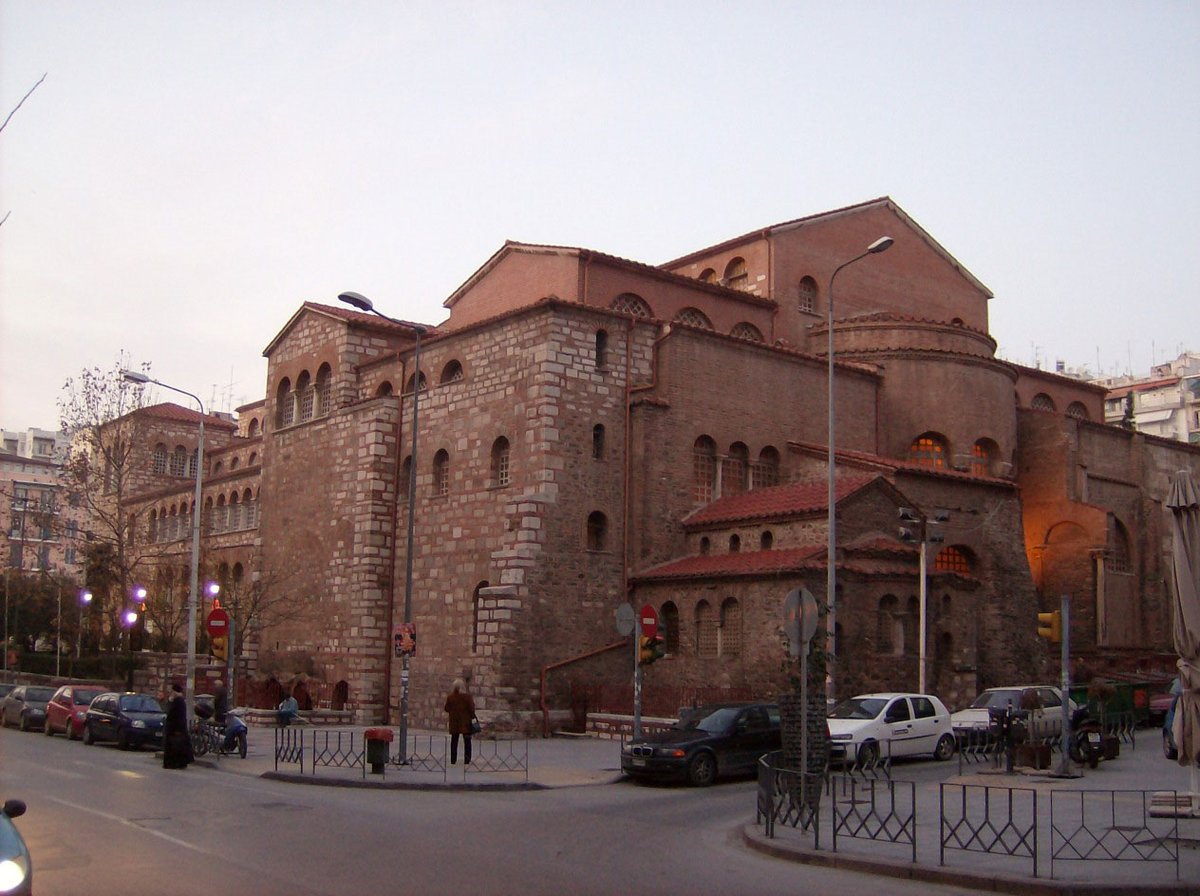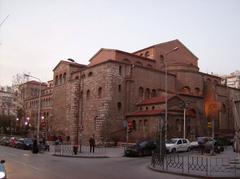
Hagios Demetrios Thessaloniki: Visiting Hours, Tickets, and Travel Guide
Date: 14/06/2025
Introduction
Hagios Demetrios, also known as the Basilica of Saint Demetrios, is Thessaloniki’s most revered religious landmark and a remarkable testament to the city’s Byzantine and multicultural history. Built over the site where Saint Demetrios, Thessaloniki’s patron saint, was martyred in the early 4th century, the basilica is not only a center for Orthodox Christian pilgrimage but also a UNESCO World Heritage Site, celebrated for its stunning architecture, mosaics, and spiritual significance. This guide provides all essential information for planning your visit, including opening hours, ticketing, accessibility, and practical travel tips, alongside insights into the basilica’s history, architecture, and surrounding attractions.
(UNESCO World Heritage)
(Trek Zone)
(Thessaloniki Tourism Official Site)
Historical and Cultural Background
Origins and Early History
The basilica stands on the site where Saint Demetrios, a Roman officer and Christian martyr, was killed around 306 AD. The original church was constructed in the early 4th century atop a Roman bath, marking Thessaloniki’s pivotal transition from paganism to Christianity. Over centuries, the basilica has witnessed destruction by fire, earthquakes, and invasions, yet has always been faithfully restored, preserving its spiritual and architectural legacy.
(Official Thessaloniki Tourism)
Architectural Evolution
Initially a small oratory, Hagios Demetrios was expanded in the late 5th–early 6th centuries into a five-aisled basilica—an architectural rarity in Greece. The structure features a spacious nave, double side aisles, a transept, and a crypt believed to be the martyrdom site of Saint Demetrios. The church’s interior is adorned with exceptional mosaics, dating from the 5th to 9th centuries, showing scenes from the saint’s life and the community that venerated him.
(Liturgical Arts Journal)
After the Ottoman conquest in 1430, the basilica was converted into the Kasımiye Camii mosque, with many Christian artworks concealed or removed. Following Thessaloniki’s liberation in 1912 and a devastating fire in 1917, the basilica was painstakingly restored, reviving its Byzantine splendor for new generations.
Pilgrimage and Multicultural Heritage
Throughout its history, Hagios Demetrios has been a focal point for religious pilgrimage, especially during the saint’s feast day on October 26th, which draws thousands of visitors and coincides with Thessaloniki’s liberation celebrations. The church has also played a role in the city’s multicultural narrative, having been a mosque during Ottoman rule and standing near the Jewish cemetery, reflecting the city’s diverse religious past.
(thessalonikilocal.com)
Architectural Features
Exterior
Hagios Demetrios is distinguished by its five-aisled basilica layout, a rarity among Byzantine monuments in Greece. The exterior is constructed from brick and stone, with arched windows and a prominent bell tower. The modest portico leads into the narthex, and the building’s harmonious proportions convey both grandeur and spiritual solemnity.
(Trek Zone)
Interior
The interior features a wide nave flanked by double aisles, separated by rows of marble columns, many repurposed from ancient Roman structures. The clerestory windows and wooden roof fill the basilica with natural light. The altar is set within a semi-circular apse at the eastern end, and a large central dome supported by pendentives adds verticality and a sense of transcendence to the space.
Mosaics and Decorative Elements
The basilica’s mosaics are masterpieces of early Byzantine art, depicting Saint Demetrios, donors, clergy, and miraculous events. Gold tesserae create a luminous effect, enhancing the spiritual ambiance. Marble revetments, intricately carved capitals, and decorative friezes further enrich the church’s interior.
(Byzantine World Mosaics)
The Crypt
Beneath the sanctuary lies the crypt, built atop the Roman bath believed to be the martyrdom site. It serves as both a museum and devotional space, displaying early Christian inscriptions, mosaic fragments, and relics. The atmospheric vaults and chapels invite contemplation and connect visitors to the church’s ancient origins.
(Trek Zone)
Visiting Information
Location and Access
- Address: 83 Agiou Dimitriou Street, Thessaloniki, Greece
- Centrally located near the Roman Forum and Ano Poli, a short walk from the city center and waterfront.
- Public Transport: Bus lines 22, 23, and 16 serve the area; tourist bus line 50 includes Hagios Demetrios as a stop.
- Parking: Public lots nearby, but may fill up during festivals.
(Greeka), (Cestee)
Opening Hours
As of June 2025:
- Basilica: Daily 07:00–21:00
- Crypt:
- Monday, Wednesday, Thursday: 08:00–15:00
- Friday: 09:00–13:30 and 19:00–22:00
- Saturday & Sunday: 07:30–14:30
- Tuesday: Closed
Note: Arrive at least 30 minutes before closing. Hours may alter for religious services or holidays.
(Thessaloniki Blog)
Admission and Tickets
- Entry: Free for both basilica and crypt. Donations are encouraged to support preservation.
(Cestee), (Laviezine)
Accessibility
- Wheelchair Access: The main basilica is accessible; the crypt has stairs and uneven surfaces, posing challenges for some visitors.
- Restrooms: Available on-site.
- Gift Shop: Sells religious items, icons, and books.
Guided Tours
- Available in several languages via local operators or arrangement with the church.
- Many Thessaloniki walking tours include Hagios Demetrios as a highlight.
(Greeka)
Visitor Tips and Etiquette
- Dress Modestly: Shoulders and knees covered for both men and women.
- Behavior: Maintain silence, especially during services; avoid flash photography.
- Photography: Permitted (without flash); always check for posted restrictions.
- Devotional Practices: Lighting candles and venerating relics are common.
- Best Times to Visit: Early mornings or late afternoons on weekdays for quieter visits.
- Special Occasions: October 26th (Saint Demetrios’ feast day) features major celebrations and large crowds.
(Lost in Times)
What to See
Inside the Basilica
- Five-aisled layout: One of the largest examples in Greece.
- Byzantine mosaics: Rare panels depicting Saint Demetrios, church founders, and local dignitaries.
- Relics: The saint’s relics and other sacred items.
The Crypt
- Martyrdom site: Believed to be where Saint Demetrios was imprisoned and killed.
- Exhibits: Early Christian artifacts, inscriptions, and restored fragments.
- Atmosphere: Dim lighting and ancient stonework evoke the early centuries of Christian worship.
Nearby Attractions
- Roman Forum: Adjacent archaeological site.
- Ano Poli (Upper Town): Byzantine and Ottoman architecture.
- Other UNESCO churches: Acheiropoietos and Panagia Chalkeon nearby.
- White Tower and Waterfront: 15-minute walk.
Frequently Asked Questions (FAQ)
Q: Is there an admission fee?
A: Entry is free; donations are appreciated.
Q: Are guided tours available?
A: Yes, via local operators or by arrangement with the church.
Q: Is the church accessible for those with mobility challenges?
A: The main basilica is accessible; the crypt is not fully accessible.
Q: Can I take photographs inside?
A: Photography is allowed without flash; restrictions during services or in certain areas may apply.
Q: When is the best time to visit?
A: Early mornings or late afternoons on weekdays are quieter. Avoid major holidays and October 26 if you prefer fewer crowds.
Visuals and Media
Alt text: Exterior and interior views of Hagios Demetrios, including mosaics and crypt.
Summary and Recommendations
Hagios Demetrios is both a living testament to Thessaloniki’s resilient spirit and a masterpiece of Byzantine art and architecture. Its five-aisled basilica, rare mosaics, and crypt offer a unique window into early Christian history and ongoing religious life. With free admission, central location, and a wealth of historical features, it is an essential destination for anyone exploring Thessaloniki.
Plan your visit with attention to opening hours, dress code, and special events. Guided tours can greatly enhance your understanding of the basilica’s art and history. To further enrich your experience, consider using interactive maps and audio guides available through apps like Audiala.
Sources and Further Reading
- UNESCO World Heritage Centre: Paleochristian and Byzantine Monuments of Thessaloniki
- Trek Zone: Hagios Demetrios, Thessaloniki
- Thessaloniki Tourism Official Site: Church of Agios Dimitrios
- Thessaloniki Local Guide: Agios Dimitrios Thessaloniki Church and Patron Saint
- Greeka: Saint Demetrius Church in Thessaloniki
- Liturgical Arts Journal: Shared Architectural Heritage
- Cestee: Basilica of St. Demetrius
- Laviezine: The Church of Hagios Demetrios
- Lost in Times: Best Places to Visit in Thessaloniki
- Thessaloniki Blog: Opening Hours and Tickets
- World City History: Thessaloniki’s Vibrant History
- Byzantine World Mosaics
For further visitor information, explore the Google Maps location and check for virtual tours and city guides.




























